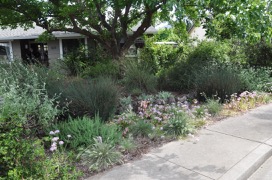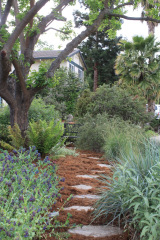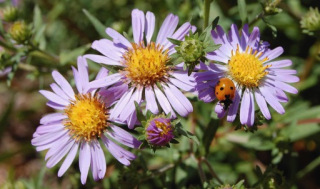Showcase Feature
In 2007, Kelly, owner of Kelly Marshall Garden Design, and her husband, Mike, wanted to transform their dull front lawn into a native plant haven for wildlife. Kelly’s goal was to design a mostly native front garden that would be attractive and interesting and attractive each season despite Clayton’s challenging microclimate. The garden has seen many days with temperatures over 100 degrees, and gets regular frost during the winter months; it even received a thin layer of snow one year.
Kelly started her planning by installing foundation plants for good “bones”, and as those have matured over the years, she continued to add and subtract plants as the garden and the family have evolved. A trickling fountain outside her home office window attracts a daily parade of birds seeking both hydration and a bath.
A strategically placed seating area provides the family with a lush, cool relaxation space, even on the warmest of days. After the front garden was finished Kelly and Mike were eager to let the back lawn go as well; in its place Kelly created a drought-tolerant meadow of bunchgrasses and flowering native perennials and wildflowers, along with a small waterfall and shallow bog that provides water to a variety of garden creatures.
Other Garden Attractions
-
- • Find out how you can receive a rebate of up to $2,000 to remove and replace your lawn with a water-wise garden! At this garden, flyers will be available with information on the Contra Costa Water District’s
-
- and free
Landscape Design Assistance Program
- . If you include 70% or more natives in your plan you can have your own garden on the Tour!
Gardening for Wildlife
Forty species of birds, and a plethora of butterflies and bees, are drawn to this garden by the sound of splashing water, the bog, and the diversity of native seed-, berry-, and pollen-bearing plants.
Soon after the garden was transformed, a pair of bluebirds, attracted by the native plants and water, raised their chicks in the nest box that had gone unnoticed by them for years! A bevy of quail have foraged and raised their chicks in the back garden near the man-made quail shelter. Checkerspot butterflies used a variety of host plants to create a caterpillar buffet line last year—Kelly and Mike found their chrysalises all over the garden afterwards. Much to the family’s delight, they were able to observe new checkerspot butterflies hatch and take flight throughout the Spring. Other visitors to the garden include fox and Pacific chorus frogs. Bats swoop overhead in the evening, noshing on mosquitoes. To keep birds safe, the family cats are kept indoors.
Keystone species in this garden (watch this talk by Doug Tallamy!)
Keystone species—our own, local ecological powerhouse plants— in this garden include vine maple, currant, California lilac, manzanita, lupine, sage, buckwheat, oceanspray, and penstemon.
Videos
“How to design a native plant meadow” by Kelly Marshall
“Gardening with California native plants: Kelly Marshall and Mike Weidner’s garden in Clayton, California” by Kelly Marshall
Photos
Click to see as a slideshow:
































